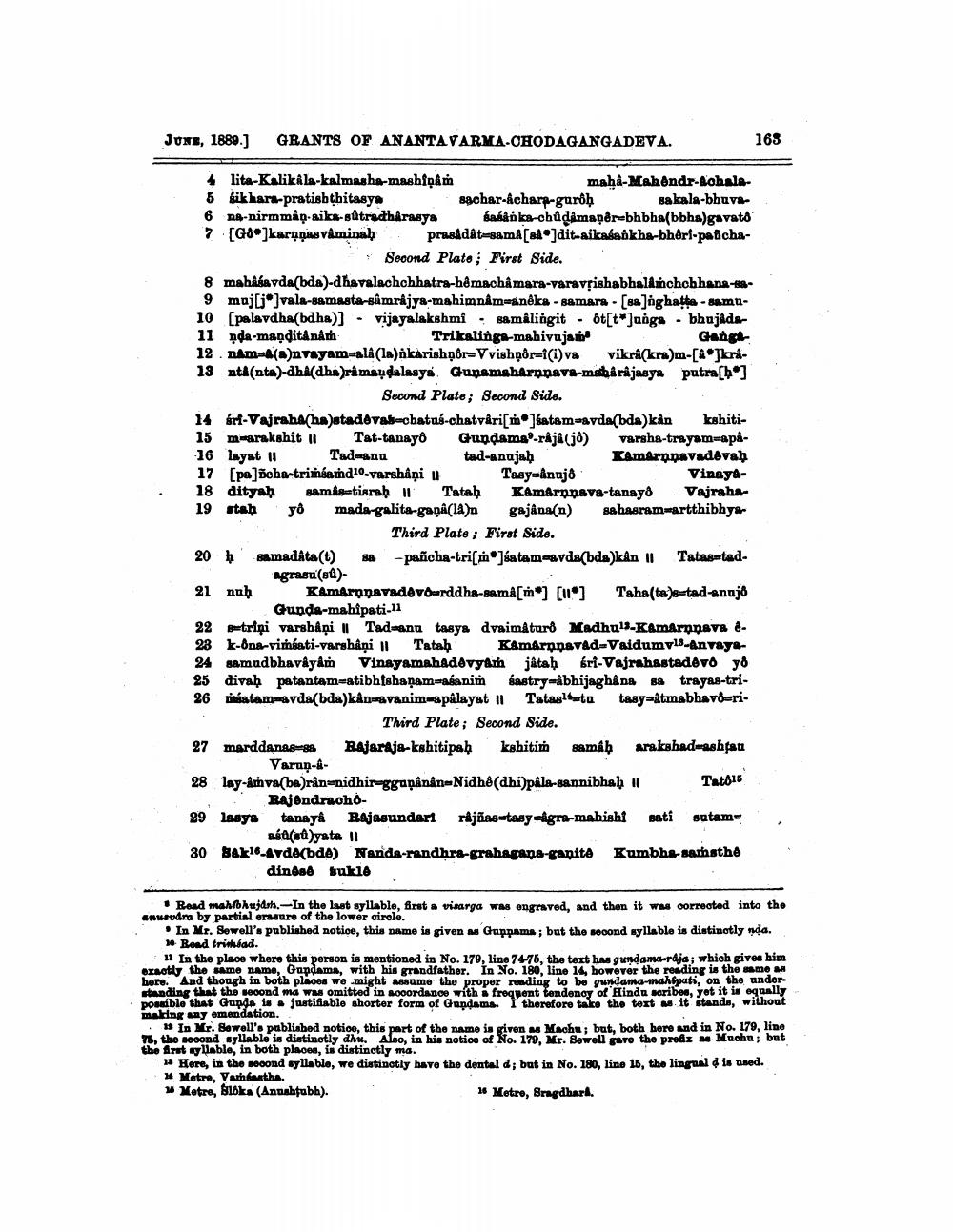________________
JUNE, 1889.] GRANTS OF ANANTAVARMA-CHODAGANGADEVA.
4 lita-Kalikala-kalmasha-mashinâm
5 sikhara-pratishthitasya
6 na-nirmmân-aika-sûtradharasya sasanka-chûdamanêr-bhbha(bbha)gavató 7 [Go]karnnasvaminah prasâdât-sama [aa]dit-aikasankha-bhêrî-pañcha
Second Plate; First Side.
maha-Mahendr-achalasakala-bhuva
sachar-âchara-guroḥ
8 mahâsavda(bda)-dhavalachchhatra-hêmachâmara-varavṛishabhalaṁchchhana-sa9 muj[j]vala-samasta-sâmrajya-mahimnâm-anêka - samara - [sa]nghaṭṭa-samu10 [palavdha(bdha)] vijayalakshmi samalingit ôt[t]unga bhujadaTrikalinga-mahivujam
Ganga
11 nda-manditânâm 12. nam (a)nvayam-ala (la)nkarishnôr-Vvishnôr-i(i) va vikra(kra)m-[*]krá13 ntâ (nta)-dhi(dha)ramandalasya Gunamsharppava-maharajasya putra[*] Second Plate; Second Side.
samadata(t) agrasu(su).
14 ri-Vajraha ha)stadevas-chatus-chatvâri[m]satam-avda(bda) kan kshiti15 marakshit || Tat-tanayo varsha-trayam-apâKamarnpavadėvaḥ Vinaya
16 layat I
Tad-anu
Gundama-raja(jo) tad-anujah Tasy-ânujo
17 [pañcha-trimsamd10.varshani |
18 dityah samas tiaraḥ || Tataḥ Kamarnnava-tanayo Vajraha19 stah mada-galita-ganaâ(1)n gajana(n) sahasram-artthibhya
yo
Third Plate; First Side.
88 -pañcha-tri[m]satam-avda(bda)kân || Tatas tad
Taha(ta)-ad-annjö
20 h
21 nuḥ
Kamarnavadevo rddha-sama[m] [11] Gunda-mahipati-11
22 striņi varshâņi | Tad-anu tasya dvaimâturô Madhu1-Kamarnnava ê23 k-ona-vimsati-varshâņi || Tataḥ Kamarnpavad-Vaidumv13-Anvaya
24 samudbhavâyâm Vinayamahadevyam jataḥ śri-Vajrahastadevo yo 25 divaḥ patantam-atibhtshanam-asanim sastry-åbhijaghâna sa trayas-tri
26 máatam-avda(bda)kan-avanim-apalayat | Tatas1tu tasy-atmabhavo-riThird Plate; Second Side.
27 marddanas-sa Rajaraja-kshitipah kahitim samâḥ arakshad-ashtau Varun-â
28 lay-imva(ba)rân-nidhir-ggapânân-Nidhê (dhi)pâla-sannibhaḥ ||
Tatô15
Rajendracho
29 lasys tanaya Rajasundari rajñas-tasy-igra-mahishi sati sutam=
ast(su)yata II
30 Bak16-avde(bde) Nanda-randhra-grahagana-ganite Kumbha-samsthe dinėse sukle
163
Read mahbhuidh.-In the last syllable, first a visarga was engraved, and then it was corrected into the anusudra by partial erasure of the lower circle.
In Mr. Sewell's published notice, this name is given as Guppama; but the second syllable is distinctly nda. 10 Bead trimhéad.
11 In the place where this person is mentioned in No. 179, line 74-75, the text has gundama-raja; which gives him exactly the same name, Gundams, with his grandfather. In No. 180, line 14, however the reading is the same an here. And though in both places we might assume the proper reading to be gundama-mahipati, on the understanding that the second ma was omitted in accordance with a frequent tendency of Hindu scribes, yet it is equally possible that Gunda is a justifiable shorter form of Gundams. I therefore take the text as it stands, without making any emendation.
13 In Mr. Sewell's published notice, this part of the name is given as Machu; but, both here and in No. 179, line 75, the second syllable is distinctly dhu. Also, in his notice of No. 179, Mr. Sewell gave the prefix as Muchu; but the first syllable, in both places, is distinctly ma.
13 Here, in the second syllable, we distinctly have the dental d; but in No. 180, line 15, the lingual d is used. Metre, Vahastha.
Metre, Bloka (Anushtubh).
16 Metre, Sragdhara.




